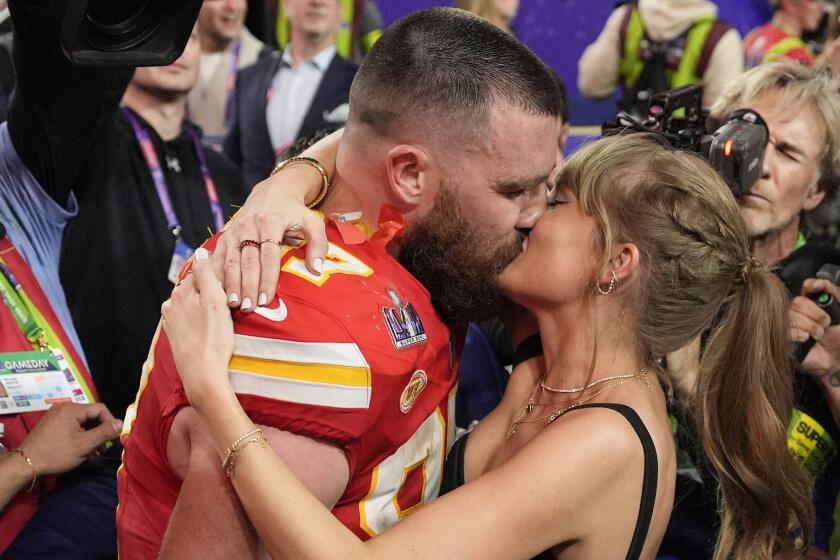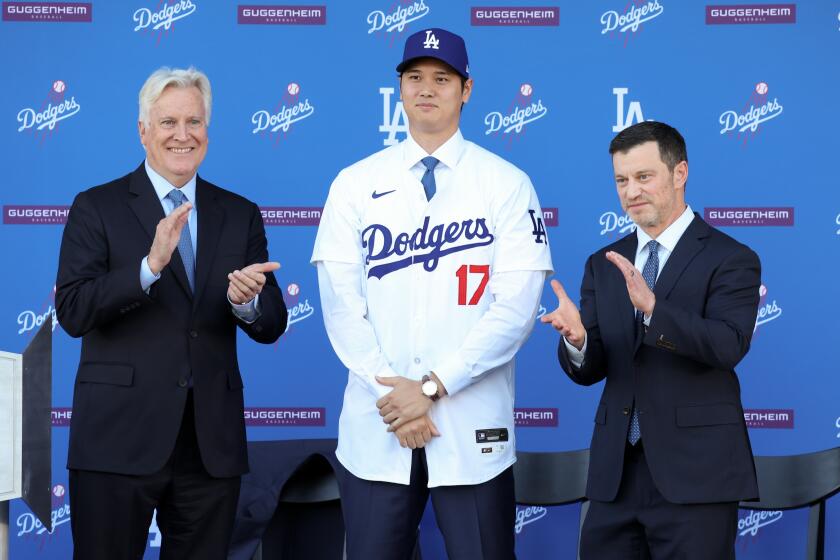Going, Going . . . : Dilapidated Olive Memorial Stadium Must Be Renovated or Razed
- Share via
Crumbling, drab, boarded up, sealed off to the public for safety reasons and defaced by graffiti, Olive Memorial Stadium in Burbank looks more hysterical than historical, but with a little twist of fate the House that Kruckeberg built might have changed the course of major league baseball.
The story begins in 1947. The city of Burbank department of parks, playgrounds and recreation spends $64,425 to construct the brick stadium. Department administrator Dewey Kruckeberg mails flyers to every major league team: spring training site available.
The St. Louis Browns bite. Beginning in 1948, the Browns use the stadium, regularly drawing crowds as large as 2,500, even though the Browns are universally recognized as the worst team in baseball. Willie Mays plays in Burbank. So does Satchel Paige, and Bobby Thomson, only a few months after his 1951 “Miracle of Coogan’s Bluff.”
In 1953, the Browns are sold and moved to Baltimore, where they become the Orioles. The new management doesn’t know Burbank from Raymond Burr and conducts spring training in Florida.
Had the Browns not been sold, who knows what would have happened? A few more springs at Olive Memorial Stadium, and the owners of the Browns might have figured out what Walter O’Malley came to realize in 1957--that Los Angeles was a big-league boom town waiting to happen--and might have preempted the Dodgers’ move.
Forty years ago, as one wag wrote, “Burbank wasn’t a town on the move--it was on the moo. As in cows.”
With room to expand back then and no homeowners associations to raise objections, Olive Memorial Stadium might have been razed to make way for a 50,000-seat monolith. Burbank, with a major league team as its main attraction, might not have become the butt of Johnny Carson jokes. The Dodgers would have stayed in Brooklyn, the Orioles wouldn’t be playing in Baltimore and Chavez Ravine would still be a residential neighborhood.
That scenario, of course, never occurred, but today the stadium is in real danger of being razed. Closed for the past three years, the stadium is structurally unsafe in its current condition and must be renovated, at a cost of about $250,000. The Burbank Department of Parks and Recreation has the money, but it is considering tearing down the venerable structure and building a new facility on the same site.
“We’re studying our options,” said Mary Alvord, acting director of the department. “Hopefully, we’ll make a decision by the middle of summer.”
To a casual observer, the stadium looks beyond help. Practically hidden from Olive Avenue by tall pine trees in a corner of George Izay Park, the stadium has suffered from neglect for decades. Cracks have appeared between the two rows of bricks that form the exterior wall. The 15 rows of wooden bleachers, situated directly behind home plate, are chipped and warped. The roof sags. Graffiti hit men managed to scale chain-link barriers and cover most available wall space.
Although the baseball infield is still in use and well-maintained, the outfield has been taken over by three lighted softball fields. Baseball, in fact, is a secondary sport at the park, the diamond used sporadically in the afternoons during the high-school season. The softball fields, on the other hand, are in use seven nights a week and all day on the weekends during most of the year, precluding use of the baseball field.
After the stadium was closed in 1988, the city of Burbank applied to the state Department of Parks and Recreation for money to restore the stadium. When the state approved a $273,000 grant, the city hired Merit Engineering of Burbank to estimate the restoration costs or even whether the structure was fixable.
The report noted that grout had deteriorated in the bricks, the steel support bars were rusting and the roof needed reinforcing to keep it from torquing in the wind and weakening the brickwork. To shore up the exterior walls, the engineers recommended constructing an interior wall of steel and gunite and tying it in to the existing brick walls.
But that creates problems. Underneath the top part of the stadium are offices with old hardwood floors that would have to be peeled back to allow construction of the new wall. If the offices were to be used after the renovation, access to them would have to be modified to allow the disabled to reach them.
“It’s possible this stadium will have to come down,” said Richard R. Inga, deputy Burbank city manager.
The state funds, however, are earmarked specifically for repairs to the stadium, although Burbank officials feel that the state would let the city use the money for other projects. Among the city’s options are leveling the stadium and building a new one from scratch on the same site or constructing bleachers along the first- and third-base lines.
Citing increased traffic, a lack of parking and the popularity of softball, Burbank officials are in agreement that a rehabilitated stadium will not be used as a home base for a minor league baseball team.
“That might have a lot of public appeal,” Alvord said, “but from a recreation sense, it’s not a great idea.”
More to Read
Go beyond the scoreboard
Get the latest on L.A.'s teams in the daily Sports Report newsletter.
You may occasionally receive promotional content from the Los Angeles Times.










